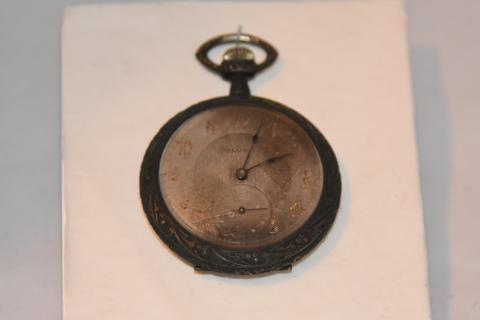This is a very elegant engraved Swiss pocket watch recovered from the battlefield at Chateau-Thierry during the final day of World War I. The watch is open-faced with gold leaf characters with a raised glass lens. The marking "Flatiron" can be made out behind the hands. The exterior casing of the watch is black, with a leaf pattern engraving. The top of the watch features a flower-shaped winder and a loop with the same leaf decoration. The rear face of the watch is engraved with images of American aviation history. The Wright Brothers' aircraft is featured most prominently, with an early airplane below it to the left and a hot air balloon below it to the right. On the base of the watch is a scene of an American landscape, with a church steeple rising over what appears to be a lake framed with trees and mountains. The sky above the landscape is filled with wispy clouds. The interior surface of the casing (which pivots open) reveals the inner mechanism of the watch, which is very well preserved. The maker's label can be seen as reading "Superior Watch Mk., Switzerland." The watch features very little patina, except on the glass lens, where there are signs that adhesive tape was applied to its surface at an unknown point in time. The Battle of Chateau-Thierry was the first major engagement of the American Expeditionary Force (AEF) and took place on July 18, 1918, under the command of General John J. Pershing. The German Army, hoping to take advantage of tied-up British forces in Flanders, advanced towards the Marne River and took the French by surprise. The AEF recognized the threat posed by the opening in their lines and moved into Chateau Thierry to cover the French retreat. After disabling most of the bridges in the town that led over the Marne, the AEF and French Army retreated to a fallback position, although the Germans were unable to take the last remaining major bridge due to Allied snipers and artillery. On the morning of July 18, the AEF and French Army launched a surprise counteroffensive. Infantry charged shortly behind a rolling artillery barrage and pierced the German lines, resulting in an Allied victory. This watch likely belonged to an American soldier who was killed in the battle. This content can be used with the following resources: SS-WH.9-12.26: Iowans Influence World History This content can be used to educate students on the impacts that Iowa soldiers had during their service in the First World War and what battles they participated in. For any use other than instructional resources, please check with the organization that owns this item for any copyright restrictions.
2018.002.041 [Watch, Pocket]
Legal Status
Copyright to this resource is held by the Iowa Masonic Library and Museum and has been provided here for educational purposes only, specifically for use in the Iowa Museum Association's "Teaching Iowa History" project. It may not be downloaded, reproduced or distributed in any format without written permission from the Rights Holder. For more information on U.S. and International copyright laws, consult an attorney.

